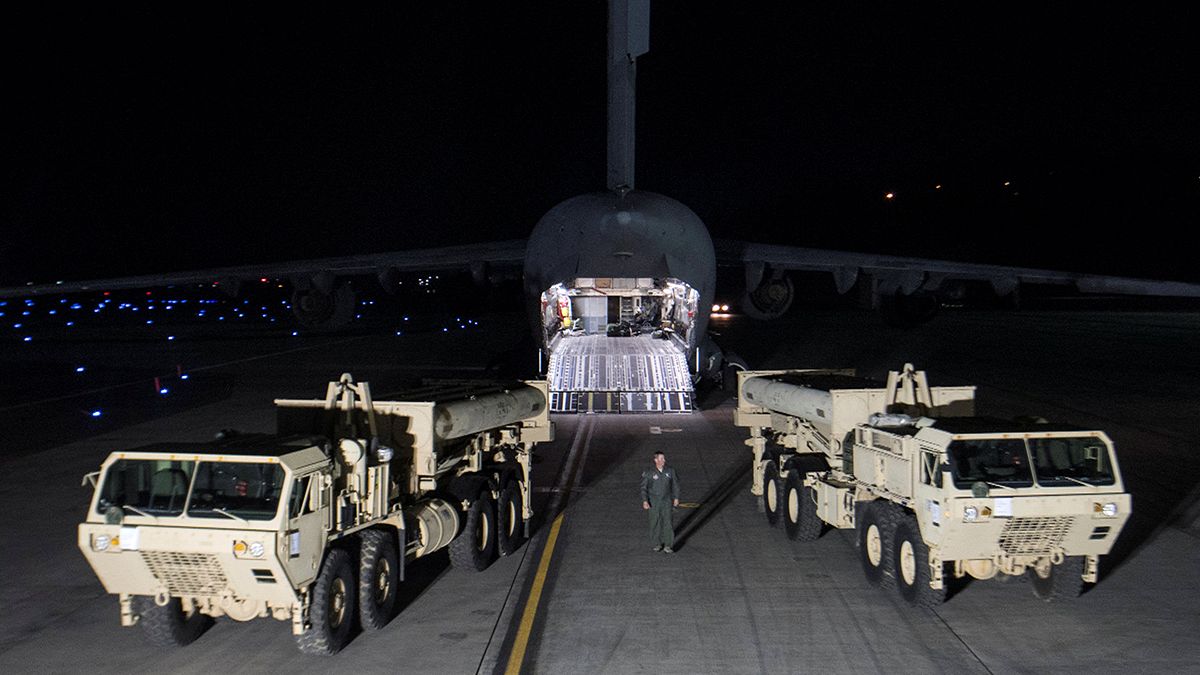The US missile deployment, which comes a day after North Korea tested four ballistic missiles, has led to diplomatic tension between China and South Korea.
The US has begun to deploy the first elements of its advanced anti-missile defence system in South Korea. It comes a day after North Korea tested four ballistic missiles.
The US announcement comes as North Korean state media said leader Kim Jong Un had personally supervised Monday’s launches.
The Yonhap news agency says the THAAD deployment could be completed in one or two months.
U.S. military says deploys THAAD anti-missile defense system in South Korea https://t.co/8KzIJs16Japic.twitter.com/vfWVrtRAxA
— Reuters Top News (@Reuters) 7 mars 2017
Le bouclier antimissile américain THAAD déployé en Corée du Sud #AFP par
AFPgraphics</a> <a href="https://t.co/Xf5XS3nKWo">pic.twitter.com/Xf5XS3nKWo</a></p>— Agence France-Presse (afpfr) 7 mars 2017
What this means
The move by the US military is likely to deepen the brewing conflict between South Korea and China.
Beijing says the THAAD deployment threatens the regional security balance.
Les États-Unis déploient le bouclier antimissiles THAAD en Corée du Sud #AFPpic.twitter.com/yS55zdlhkP
— Agence France-Presse (@afpfr) 7 mars 2017
What happened to North Korea’s missiles?
They landed in the sea off north-western Japan. Coming days after Pyongyang promised retaliation over the military drills that it sees as preparation for war, the tests angered Seoul and Tokyo.
Analysts in South Korea say the missiles were unlikely to have been intercontinental ballistic missiles (ICBMs), which can reach the US.
They flew an estimated 1,000 km and reached an altitude of 260 km. Japan’s defence minister says some landed as close as 300km from Japan’s northwest coast.
South Korean military and intelligence officials say the four North Korean missiles appear to have been upgraded versions of the extended range SCUD – type.
What has North Korea said?
Pyongyang has issued what commentators describe as a “typically robust” statement via the state news agency, KCNA.
“In the hearts of artillerymen…there was burning desire to mercilessly retaliate against the warmongers going ahead with their joint war exercise,” KCNA said.
It was reportedly a training exercise for a strike on US bases in Japan.
#BREAKING North Korea missile launch was training exercise for strike on US bases in Japan: KCNA
— AFP news agency (@AFP) 6 mars 2017
KCNA says Kim has ordered the Korean People’s Army’s Strategic Force “to keep highly alert as required by the grim situation on which an actual war may break out at any time, and get fully ready to promptly move, take positions and strike so that it can open fire to annihilate the enemies.”
UNSC meeting request
The US and Japan have asked for a UN Security Council meeting in the wake of North Korea’s latest launches.
Diplomats think this could come as early as Wednesday.
China and South Korea
The US missile deployment has led to diplomatic tension between China and South Korea.
The Chinese authorities have closed nearly two dozen retail stores belonging to South Korea’s Lotte Group. Last week, it approved a land swap with the military to allow the system to be installed.
On Tuesday, spokesman Geng Shang said Beijing would take all the steps necessary to protect its security interests.
“The consequences of this are on the shoulders of the US and South Korea. We again strongly urge the relevant sides to stop the deployment process and not keep going down the wrong path,” Shang said.
China’s state-run Global Times warned the possibility of war on the Korean peninsula was growing because of the US-South Korean military drills and the North Korean missile launches.
“The Chinese public is angry that Pyongyang’s nuclear progamme has provided an excuse for Seoul to deploy THAAD,” the paper said in an editorial.
What they are saying
“Continued provocative actions by North Korea, to include yesterday’s launch of multiple missiles, only confirm the prudence of our alliance decision last year to deploy THAAD to South Korea,” – US Pacific Commander Admiral Harry Harris gives the Terminal High Altitude Area Defense system its full name.
“Japan and the US confirmed that the latest North Korean missile launches were clearly against UN resolutions and a clear provocation against the regional and international community,” – Japanese Prime Minister Shinzo Abe has discussed the launches with US president, Donald Trump.
